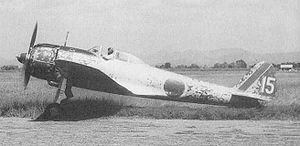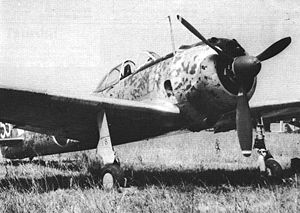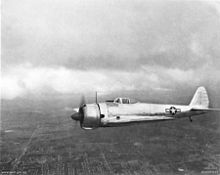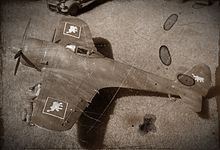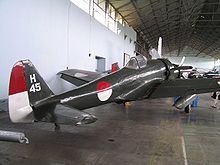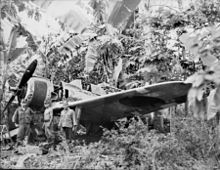- Nakajima Ki-43
-
Ki-43 "Hayabusa" A Nakajima Ki-43-IIa Role Fighter aircraft Manufacturer Nakajima Aircraft Company Designer Yasushi Koyama, Hideo Itokawa First flight Early January 1939[1] Retired 1945 (Japan)
1952 (China)Primary users Imperial Japanese Army Air Force
Royal Thai Air Force
Manchukuo Air ForceProduced 1942–1945 Number built 5,919 The Nakajima Ki-43 Hayabusa (隼, "Peregrine Falcon") was a single-engine land-based tactical fighter used by the Imperial Japanese Army Air Force in World War II. The army designation was "Army Type 1 Fighter" (一式戦闘機); the Allied reporting name was "Oscar", but it was often called the "Army Zero" by American pilots for its resemblance to the Mitsubishi A6M Zero,[2] which was flown by the Japanese Navy.
Like the A6M, the radial-engined Ki-43 was light and easy to fly, and became legendary for its combat performance in East Asia in the early years of the war. It could outmaneuver any opponent, but did not have armor or self-sealing tanks, and its armament was poor until the last version, which was produced as late as 1944.[3] Allied pilots often reported that the nimble Ki-43s were difficult targets, but burned easily or broke apart with few hits.[4] In spite of its drawbacks, the Ki-43 shot down more Allied aircraft than any other Japanese fighter and almost all the JAAF'S aces achieved most of their kills in it.
Total production amounted to 5,919 aircraft.[5] Many of these were used during the last months of the war for kamikaze missions against the American fleet.[4]
Contents
Design and development
The Ki-43 was designed by Hideo Itokawa, who would later become famous as a pioneer of Japanese rocketry. The Ki-43 prototype was produced in response to a December 1937 specification for a successor to the popular fixed-gear Nakajima Ki-27 Nate. The specification called for a top speed of 500 km/h (311 mph), a climb rate of 5,000 m (16,400 ft) in five minutes and a range of 800 km (500 mi). Maneuverability was to be at least good as the Ki-27.[6]
When first flown in early January 1939,[7] the Ki-43 prototype was a disappointment. Japanese test pilots complained that it was less maneuverable than the Ki-27 and not much faster.[8] In order to solve these problems, Nakajima produced a series of progressively modified prototypes through 1939 and 1940. These changes involved a major weight saving program, a slimmer fuselage with the tail surfaces moved further aft and a new canopy. Crucially, the 11th prototype introduced the unique "butterfly" (or Fowler-type) maneuvering flaps, which dramatically improved performance in tight turns. The 13th prototype combined all these changes, and tests of this aircraft resulted in an instruction for Nakajima to place the Ki-43 into production, the Ki-27 jigs being transferred to the Mansyu factory at Harbin in Japanese occupied Manchukuo.[9]
The initial production version was given the designation Ki-43-I. Deliveries from Nakajima's Ota factory commenced in April 1941. In addition to outstanding maneuverability, the Ki-43-I had a very impressive rate of climb due to its light weight. Power was provided by the Nakajima Ha-25 engine turning a two bladed, two-pitch metal propeller.[10] Top speed was 495 km/h (308 mph) at 4,000 m (13,160 ft).[11] The Ki-43 was equipped with two cowling machine guns in various configurations, with either two 7.7 mm (.303 in) Type 97 machine guns, one 12.7 mm (.50 in) Ho-103 machine gun and one 7.7 mm (.303 in) gun, or two 12.7 mm (.50 in) Ho-103 guns; the aircraft was given various sub-designations to reflect these differences. The configuration that appears to have been most prevalent at the outset of the war was the first configuration with two 7.7 mm (.303 in) Type 97 machine guns, while as the war progressed the heavier combinations gained popularity and the version with the heaviest armament was sometimes given the designation Ki-43-Ic.[12] The Ho-103 was often loaded with explosive ammunition to increase target effect; its penetrative effect against later Allied aircraft armor appears to have been marginal.[12]
Prototypes for the Ki-43-II flew in February 1942. The Ha-25 engine was replaced by the more powerful Nakajima Ha-115 engine, which was installed in a longer-chord cowling. The new engine turned a three-bladed propeller. The wing structure, which had suffered failures in the Ki-43-I, was strengthened and equipped with racks for drop tanks or bombs. The Ki-43-II was also fitted with 13 mm armor plate for the pilot's head and back, and the aircraft's fuel tanks were coated in rubber to form a crude self-sealing tank. The pilot also enjoyed a slightly taller canopy and a reflector gunsight in place of the earlier telescopic gunsight.[13] Nakajima commenced production of the Ki-43-II at its Ota factory in November 1942.[14] Production was also started at the Tachikawa Hikoki KK and the 1st Army Air Arsenal (Tachikawa Dai-Ichi Rikugun Kokusho), also at Tachikawa. Although Tachikawa Hikoki successfully managed to enter into large scale production of the Ki-43, the 1st Army Air Arsenal was less successful, being hampered by a shortage of skilled workers, being ordered to stop production after 49 Ki-43s were built.[15] Nakajima eventually ceased production in mid-1944 in favor of the Ki-84, but the Tachikawa Hikoki continued to produce the Ki-43.[16]
Tachikawa also produced the Ki-43-III, which utilized the more powerful Nakajima Army Type 1 Ha-115-II engine. Maximum speed increased to 358 mph.[16] Tachikawa produced 2124 Ki-43-II and -III aircraft between April 1944 and the end of the war.[17] Total production of all versions amounted to 5,919 aircraft.[11]
Operational history
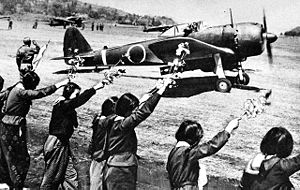 A Ki-43 III-Ko, piloted by Second Lieutenant Toshio Anazawa and carrying a 250 kg (550 lb) bomb, sets off from the Japanese airfield of Chiran for the Okinawa area, on a kamikaze mission, 12 April 1945. School girls wave goodbye in the foreground.
A Ki-43 III-Ko, piloted by Second Lieutenant Toshio Anazawa and carrying a 250 kg (550 lb) bomb, sets off from the Japanese airfield of Chiran for the Okinawa area, on a kamikaze mission, 12 April 1945. School girls wave goodbye in the foreground.
The Ki-43 was the most widely-used Army fighter, and equipped 30 sentai (groups) and 12 chutais (independent squadrons). The first version, Ki-43-I, entered service in 1941, the Ki-43-II in December 1942, the Ki-43-II-Kai in June 1943, and the Ki-43-IIIa in summer 1944. The aircraft fought in China, Burma, the Malay Peninsula, New Guinea, the Philippines, South Pacific islands and the Japanese home islands.[5]
Like the Zero, the Ki-43 initially enjoyed air superiority in the skies of Malaya, Netherlands East Indies, Burma and New Guinea. This was partly to do with the better performance of the Oscar[18] and partly due to the relatively small numbers of combat-ready Allied fighters, mostly the P-36 Hawk, Curtiss P-40, Brewster Buffalo, Hawker Hurricane and Curtiss-Wright CW-21 in Asia and the Pacific during the first months of the war. As the war progressed, however, the fighter suffered from the same weaknesses as the Ki-27 "Nate" and the A6M Zero; light armor and less-than-effective self-sealing fuel tanks, which caused high casualties in combat. Its armament of two machine guns also proved inadequate against the more heavily armored Allied aircraft. As newer Allied aircraft were introduced, such as the P-47 Thunderbolt, P-38 Lightning, P-51 Mustang, F4U Corsair, F6F Hellcat and late-model Supermarine Spitfire/Seafire, the Japanese were forced into a defensive war and most aircraft were flown by inexperienced pilots. However, even towards the end, the Oscar's excellent maneuverability could still gain advantage over rash Allied pilots. From October to December 1944, 17 Ki-43s were shot down in air combat, but they accounted for seven C-47s, five B-24 Liberators, two Spitfires, two Beaufighters, two Mosquitoes, two F4U Corsairs, two B-29 Superfortresses, one F6F Hellcat, one P-38, and one B-25.[19] Like most Japanese combat types, many Hayabusas were at the end expended in kamikaze raids.
The Ki-43 also served in an air defense role over Formosa, Okinawa and the Japanese home islands. Some examples were supplied to the pro-Japanese regimes of Thailand, Manchukuo and Wang Jingwei Government as well. The Thai units sometimes fought against the USAAF in southern China.[20]
Hayabusas were well liked in the JAAF because of the pleasant flight characteristics and excellent maneuverability, and almost all JAAF fighter aces claimed victories with Hayabusa in some part of their career. At the end of the war, most Hayabusa units received Ki-84 Hayate "Frank" fighters, but some units flew the Hayabusa to the end of the war. The top-scoring Hayabusa pilot was Sergeant Satoshi Anabuki with 39 confirmed victories, almost all of them scored with the Ki-43.
After the war, some captured examples served in limited numbers in the French Air Force in Indochina against Viet Minh rebels.[21]
Variants
- Ki-43
- Prototypes and operative prototypes.
- Ki-43-Ia
- Variant armed with 2 × 7.7 mm (.303 in) Type 97 machine guns
- Hayabusa Fighter Type 1 of Army (Mark 1).
- Ki-43-Ib (Mark Ib)
- Variant armed with one 12.7 mm (.50 in) Ho-103 machine gun and 1 × 7.7 mm (.303 in) Type 97
- Ki-43-Ic (Mark Ic)
- Variant armed with 2 × 12.7 mm (.50 in) Ho-103
- Ki-43-II
- Prototypes and evaluative models.
- Ki-43-IIa (Mark 2a)
- Ability to carry up to 500 kg (1,100 lb) of bombs
- Ki-43-IIb (Mark 2b)
- Radio equipment added
- Ki-43-II-KAI
- Fitted with ejector exhaust stacks
- Ki-43-III
- Prototypes powered by Nakajima Ha-115-II engine of 920 kW (1,230 hp)
- 2 × 170 L (45 gal) drop tanks (~3 hour full-throttle endurance)
- Ki-43-IIIa (Mark 3a)
- Series model
- Ki-43-IIIb (Mark 3b)
- Variant armed with 20 mm cannons.
- Ki-62 Project
- Advanced interceptor version of Nakajima Ki-43 with a powerful engine and armed with 30 mm (1.18 in) or 40 mm (1.57 in) cannons.
Operators
Wartime
- Manchukuo Air Force
Postwar
- Nationalist Chinese Air Force
- 6th Group
- Two squadrons operated captured aircraft.
- 6th Group
- Chinese Communist Air Force captured five aircraft in 1946 from nationalists. Aircraft were operated until their retirement in 1952.
- French Air Force Escadron de Chasse 1/7[22] operated captured aircraft in 1945-6 Indo-China.[23]
- Indonesian People's Security Force operated derelict aircraft against Dutch colonial rule. On 29 July 1947, Indonesia intended to use a Ki-43 from Maguwo Air Force Base, Yogyakarta for bombing Dutch strategic positions in Ambarawa, Salatiga and Semarang. However, it failed to fly because of mechanical problems. It is currently on display in the Museum Dirgantara Udara Yogyakarta (near Adisucipto International Airport).
- North Korean Air Force operated derelict aircraft after the war.
Survivors
There is currently only one airworthy Oscar located at the Tillamook Air Museum. There are six survivors in potentially flyable condition:[24]
- Ki-43
- Owned by The Fighter Collection, Duxford UK and awaiting restoration.
- Ki-43-Ib N750N
- Owned by Paul Allen/Flying Heritage Collection, Arlington, Washington, USA. Former ZK-OSC restored to flying condition by the Alpine Fighter Collection in the 1990s, not currently flying.
- Ki-43-IIb
- Seattle Museum of Flight
- Ki-43-IIb
- Pima Air Museum, static display in Hangar 4[25]
- Ki-43-IIIb
- Four aircraft under restoration/rebuild at Texas Airplane Factory, Meacham Field, Fort Worth, Texas, USA.
- Ki-43-IIIb
- Tillamook Air Museum in Oregon, USA..[26][27]
Specifications (Ki-43-IIb)
Data from Japanese Aircraft of the Pacific War[28]
General characteristics
- Crew: One
- Length: 8.92 m (29 ft 3⅜ in)
- Wingspan: 10.84 m (35 ft 6¾ in)
- Height: 3.27 m (10 ft 8¾in)
- Wing area: 21.4 m² (230.4 ft²)
- Empty weight: 1,910 kg (4,211 lb)
- Loaded weight: 2,590 kg (5,710 lb)
- Max takeoff weight: 2,925 kg (6,450 lb)
- Powerplant: 1 × Nakajima Ha-115 fourteen cylinder air-cooled radial engine, 858 kW (1,150 hp)
Performance
- Maximum speed: 530 km/h (286 knots, 329 mph) at 4,000 m (13,125 ft)
- Cruise speed: 440 km/h (237 knots, 273 mph)
- Range: 1,760 km (952 nmi, 1095 mi)
- Ferry range: 3,200 km (1,730 nmi, 1,990 mi)
- Service ceiling: 11,200 m (36,750 ft)
- Wing loading: 121 kg/m² (24.8 lb/sq ft)
Armament
- Guns: 2× fixed, forward-firing 12.7 mm (.50 in) Ho-103 machine guns in the cowl with 250 rpg
- Bombs: 2× 250 kg (551 lb) bombs
See also
- Related development
- Aircraft of comparable role, configuration and era
- Bloch MB.152
- Curtiss P-36
- Curtiss-Wright CW-21
- IAR 80
- Macchi MC.200
- Mitsubishi A6M
- Polikarpov I-180
- Reggiane Re.2000
- Related lists
References
- Notes
- ^ Francillon, René J., Japanese Aircraft of the Pacific War, Annapolis, Maryland: Naval Institute Press, 1979, ISBN 0-87021-313-X, p. 207.
- ^ Stanaway 2003, p. 33.
- ^ Ethell 1995, pp. 98–99.
- ^ a b Ethell 1995, p. 99.
- ^ a b Glancey 2006, p. 173.
- ^ Francillon 1979, p. 206.
- ^ Francillon, René J., Japanese Aircraft of the Pacific War, Annapolis, Maryland: Naval Institute Press, 1979, ISBN 0-87021-313-X, p. 166.
- ^ Air International January 1980, p. 27.
- ^ Air International January 1980, pp. 27—28.
- ^ Air International January 1980, p. 28.
- ^ a b Francillon 1979, p. 214.
- ^ a b Dunn, Richard L. "Nakajima Ki-43-I Armament: A Reassessment." warbirdforum.com. Retrieved: 18 October 2009.
- ^ Air International January 1980, p. 44.
- ^ Francillon 1979, p. 210.
- ^ Francillon 1979, p. 211.
- ^ a b Air International January 1980, p. 45.
- ^ Air International January 1980, p. 46.
- ^ Stanaway 2006, p. 9.
- ^ Ichimura 2009, p. 50.
- ^ j-aircraft.com/research "Royal Thai Air Force aircraft." j-aircraft.com. Retrieved: 18 October 2009.
- ^ Dorr and Bishop 1996, p. 249.
- ^ March and Heathcott 1997, p. 75.
- ^ "French Counter-Insurgency Aircraft, 1946–1965." worldatwar.net. Retrieved: 18 October 2009.
- ^ "Flying Warbirds and Antiques." home1.gte.net. Retrieved: 18 October 2009.
- ^ "Nakajima Ki-43-IIb." Pima Air Museum. Retrieved: 18 October 2009.
- ^ 21st century Oscars
- ^ "Oscar." Tillamook Air Museum. Retrieved: 18 October 2009.
- ^ Francillon 1979, pp. 213–214.
- Bibliography
- Bueschel, Richard M. Nakajima Ki-43 Hayabusa I-III in Japanese Army Air Force RTAF-CAF-IPSF Service. Reading, Berkshire, UK: Osprey Publications, 1970. ISBN 0-85045-022-5.
- Bueschel, Richard M. Nakajima Ki-43 Hayabusa in Japanese Army Air Force RTAF-CAF-IPSF Service. Atglen, PA: Schiffer Books, 1995. ISBN 0-88740-804-4.
- Dorr, Robert F. and Chris Bishop. Vietnam Air War Debrief. London: Aerospace, 1996. ISBN 1-874023-78-6.
- Ethell, L. Jeffrey. Aircraft of World War II. Glasgow: HarperCollins Publishers, 1995. ISBN 0-00-470849-0.
- Francillon, René J. Japanese Aircraft of the Pacific War. London: Putnam & Company, 1970. ISBN 0-370-00033-1 1979 edition, ISBN 0-370-30251-6.
- Glancey, Jonathan. Spitfire: The Illustrated Biography. London: Atlantic Books, 2006. ISBN 978-1-84354-528-6.
- Green, William. Warplanes of the Second World War, Volume Three: Fighters. London: Macdonald & Co. (Publishers) Ltd., 1961 (seventh impression 1973). ISBN 0-356-01447-9.
- Green, William and Gordon Swanborough. WW2 Aircraft Fact Files, Japanese Army Fighters, part 2. London: Macdonald and Janes's, 1977. ISBN 0-354-01068-9.
- Ichimura, Hiroshi. Ki-43 'Oscar' Aces of World War II. Oxford, UK: Osprey, 2009. ISBN 978-1846034084.
- March, Daniel J. and John Heathcott, eds.The Aerospace Encyclopedia of Air Warfare Volume Two: 1945 to the Present. London: AIRtime Publishing, 1997. ISBN 1-87402-388-3.
- "Pacific Peregrine... The Nakajima Ki.43 Hayabusa". Air International, January 1980, Vol 18 No 1, pp. 27–31, 44 46. Bromley, UK: Fine Scroll. ISSN 0306-5634.
- Pajdosz, Waldemar, Mark T. Wlodarczyk and Adam Jarski. Nakajima Ki 43 Hayabusa "Oscar" (in Polish), Monografie Lotnicze 48. Gdańsk: AJ-Press, 1998. ISBN 83-86208-97-X.
- Skulski, Przemysław. Nakajima Ki 43 Hayabusa "Oscar", seria Pod Lupa no.11 (Polish/English). Wrocław: Ace Publications, 1999. ISBN 83-86153-98-9.
- Stanaway, John. Nakajima Ki.43 "Hayabusa" – Allied Code Name "Oscar". Bennington, VT: Merriam Press, 2003 (2nd expanded edition 2006). ISBN 1-57638-141-2.
- Windrow, Martin C. and René J. Francillon. The Nakajima Ki-43 Hayabusa. Leatherhead, Surrey, UK: Profile Publications, 1965.
External links
- Nathan Sturman's Homepage
- Joe Baugher's Hayabusa files
- Nakajima Type 1 Model 1 Army Fighter (Ki 43-I) Armament – A Reassessment by Richard L. Dunn
Aircraft produced by Nakajima Aircraft Company Imperial Japanese Navy types Imperial Japanese Army types World War II Allied reporting names Imperial Japanese Army Air Force aircraft designations 1-50 Ki-1 • Ki-2 • Ki-3 • Ki-4 • Ki-5 • Ki-6 • Ki-7 • Ki-8 • Ki-9 • Ki-10 • Ki-11 • Ki-12 • Ki-13 • Ki-14 • Ki-15 • Ki-16 • Ki-17 • Ki-18 • Ki-19 • Ki-20 • Ki-21 • Ki-22 • Ki-23 • Ki-24 • Ki-25 • Ki-26 • Ki-27 • Ki-28 • Ki-29 • Ki-30 • Ki-31 • Ki-32 • Ki-33 • Ki-34 • Ki-35 • Ki-36 • Ki-37 • Ki-38 • Ki-39 • Ki-40 • Ki-41 • Ki-42 • Ki-43 • Ki-44 • Ki-45 • Ki-46 • Ki-47 • Ki-48 • Ki-49 • Ki-50
51-100 Ki-51 • Ki-52 • Ki-53 • Ki-54 • Ki-55 • Ki-56 • Ki-57 • Ki-58 • Ki-59 • Ki-60 • Ki-61 • Ki-62 • Ki-63 • Ki-64 • Ki-66 • Ki-67 • Ki-68 • Ki-69 • Ki-70 • Ki-71 • Ki-72 • Ki-73 • Ki-74 • Ki-75 • Ki-76 • Ki-77 • Ki-78 • Ki-79 • Ki-80 • Ki-81 • Ki-82 • Ki-83 • Ki-84 • Ki-85 • Ki-86 • Ki-87 • Ki-88 • Ki-89 • Ki-90 • Ki-91 • Ki-92 • Ki-93 • Ki-94 • Ki-95 • Ki-96 • Ki-97 • Ki-98 • Ki-99 • Ki-100
100- World War II Allied reporting names for Japanese aircraft Aircraft in Japanese service Abdul • Alf • Ann • Babs • Baka • Belle • Betty • Bob • Buzzard • Cedar • Cherry • Clara • Claude • Cypress • Dave • Dick • Dinah • Dot • Edna • Emily • Eva • Eve • Frances • Frank • Gander • George • Glen • Goose • Grace • Gwen • Hamp • Hank • Hap • Helen • Hickory • Ida (Tachikawa Ki-36) • Ida (Tachikawa Ki-55) • Irving • Jack • Jake • Jane • Jean • Jerry • Jill • Jim • Judy • Kate • Kate 61 • Laura • Lily • Liz • Lorna • Loise • Louise • Luke • Mabel • Mary • Mavis • Myrt • Nate • Nell • Nick • Norm • Oak • Oscar • Pat • Patsy • Paul • Peggy • Perry • Pete • Pine • Rex • Rita • Rob • Rufe • Ruth • Sally • Sally III • Sam • Sandy • Slim • Sonia • Spruce • Stella • Steve • Susie • Tabby • Tess • Thalia • Thelma • Theresa • Thora • Tina • Tillie • Toby • Tojo • Tony • Topsy • Val • Willow • Zeke • Zeke 32
Nonexistent aircraft thought to be in Japanese service Adam • Ben • Doris • Gus • Harry • Ione • Joe • Joyce • Julia • June • Norma • Omar • Ray
Foreign aircraft erroneously thought to be in Japanese service Lists relating to aviation General Aircraft (manufacturers) · Aircraft engines (manufacturers) · Airlines (defunct) · Airports · Civil authorities · Museums · Registration prefixes · Rotorcraft (manufacturers) · TimelineMilitary Accidents/incidents Records Categories:- Propeller aircraft
- Low wing aircraft
- Single-engine aircraft
- Japanese fighter aircraft 1930–1939
- World War II Japanese fighter aircraft
- Nakajima aircraft
Wikimedia Foundation. 2010.

